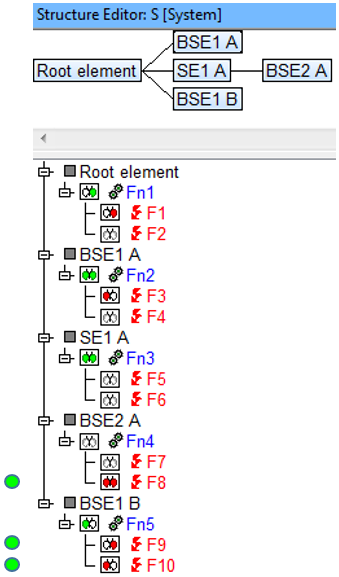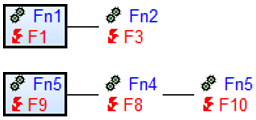Search:
Linked failures with non-compliant VDA function links
Explanation:
A search will be made for linked failures, anchored at functions which are not linked in compliance with VDA handbook. VDA compliance here means that function links must exist analogous to the failure links.
This Quality Rule does not consider failure links that are opposite in direction than their corresponding function links. This search can be checked using a different Quality Rule.
Example:
Abbreviations
- ASIL = Automotive safety integrity level
- BF = Base failure of a base function
- BFn = Base function of a base structure element
- BSE = Base structure element
- Cl Prc = Classification for process characteristic
- Cl Prd = Classification for product characteristic
- Cl Req = Classification for requirement
- CM = Control method
- DA = Detection action
- DC = Diagnostic coverage
- DSCF = Dangerous safety critical failure
- Er Det = Error detection
- Er Resp = Error response
- F = Failure
- FIT = Failure in time
- Fn = Function
- FSM = Functional safety management
- IE = Inspection equipment
- LF = Latent fault
- LFM = Latent fault metric
- OC = Operating condition
- PA = Preventive action
- PE = Process element
- PFH = Probability of failure per Hour
- PMHF = Probabilistic metric for random hardware failures
- PrcC = Process characteristic
- PrdC = Product characteristic
- QM = Quality method
- QR = Quality rule
- Req = Requirement
- RMR = Risk Matrix Ranking
- RP = Reaction plan
- SE = Structure element
- SE ErDet = Structure element for error detections
- SE ErResp = Structure element for error responses
- SFF = Safe failure fraction
- SG = Safety Goal
- SIL = Safety integrity level
- SM = Organisational-SE for “safety mechanisms”
- SPF = Single point fault
- SPFM = Single point fault metric
- TF = Top failure of a top function
- TFn = Top function at root element
- TS = Test sample

- In each of the five structure elements, there is a function with two failures anchored.
- The hot-click icon to the left of the function name indicates, that all but Fn4 are linked in function nets. The only function net that exists for this example can be seen below.
![]()
- The hot-click icon to the left of the failure name indicates how and if a failure is linked in a failure net. The following two failure nets exist for this example:

- This Quality Rule finds linked failures (F2, F4, F5, F6 and F7 are therefore not considered), which are anchored at functions which are not linked. If a linked failure is anchored at an unlinked function it is not VDA compliant. If functions are linked but in the opposite direction to their anchored failures, this is also non-compliant, but this search is covered in a different Quality Rule.
- Failure F8, which is linked in a failure net and anchored at function Fn4 which isn’t, is a hit for this example.
- Failure F7, also anchored to Fn4 is not a hit, as it itself is not linked in a failure net.
- Using the function- and failure net images, it is possible to analyze the other objects more closely. F1 is linked to F3. If the function that F1 is anchored to is linked to function that has F3 anchored to it, it is VDA compliant. This is the case, as FN1 is linked to Fn2. Therefore, F1 and F3 are VDA compliant.
- Failures F8, F9 and F10 are linked in a failure net anchored at functions that do not correspond with the function net. In the function net, you can see that the functions Fn4 and Fn5 are not linked.
Search result: ![]()
There are 3 hits for this example: FF8, F9 and F10.


